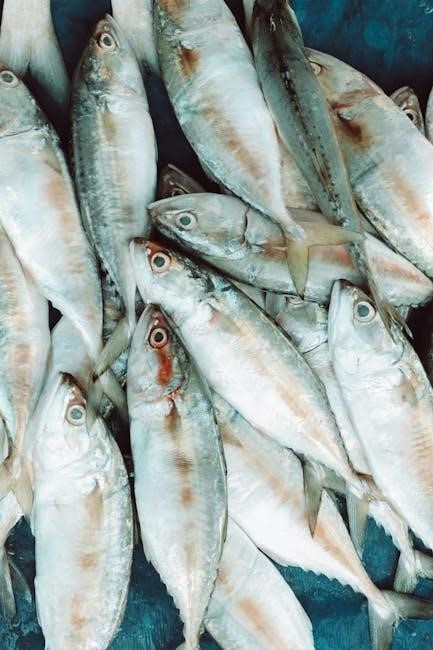
Best Locations for Saltwater Fishing
Capture the thrill of saltwater fishing in coastal areas, beaches, estuaries, mangroves, coral reefs, and offshore spots. These diverse ecosystems offer abundant species and unique fishing experiences year-round.
1.1. Coastal Areas and Beaches
Capture the thrill of saltwater fishing in coastal areas and beaches, where diverse species like striped bass and tarpon thrive. These accessible spots offer rich fishing experiences, with piers, jetties, and shorelines providing ideal casting points for both beginners and seasoned anglers.
1.2. Offshore Fishing Spots
Offshore fishing spots, such as reefs, oil rigs, and deep-sea structures, attract large species like tuna, marlin, and grouper; These locations require a boat and often yield abundant catches. The open ocean offers a thrilling experience for anglers seeking adventure and trophy fish, making it a must-visit for serious enthusiasts.
1.3. Estuaries and Mangroves
Estuaries and mangroves are nutrient-rich ecosystems where freshwater meets the ocean, supporting diverse marine life. These areas are ideal for catching species like snook, tarpon, and redfish. The intricate vegetation provides cover for fish, making them prime spots for anglers seeking a variety of saltwater species in a unique environment.
1.4. Coral Reefs
Coral reefs are vibrant ecosystems teeming with marine life, offering excellent saltwater fishing opportunities. These underwater structures attract species like grouper, snapper, and tuna. Reefs provide both food and shelter for fish, making them hotspots for anglers seeking diverse catches in tropical and subtropical waters.
Understanding Tides and Weather
Mastering tides and weather is crucial for successful saltwater fishing. Tides dictate fish movement, while weather conditions like wind and waves impact fishing accessibility and fish behavior significantly.
2.1. Importance of Tides in Fishing
Tides significantly influence saltwater fishing by determining fish movement and feeding patterns. Rising tides often bring baitfish to shore, attracting larger predators, while falling tides expose structures that concentrate fish, making them easier to locate and catch effectively.
2.2. Weather Conditions for Optimal Fishing
Calm seas and clear skies offer ideal conditions for saltwater fishing, enhancing visibility and fish activity. Overcast skies can stimulate feeding, while strong winds or storms often reduce fish movement. Monitoring weather forecasts helps anglers plan trips effectively, ensuring safer and more productive fishing experiences.
Essential Gear for Saltwater Fishing
Essential gear includes durable rods, reels, lines, hooks, and sinkers. Choose tackle and bait suitable for target species to ensure a successful fishing experience.
3.1. Fishing Tackle
Fishing tackle is a cornerstone of saltwater fishing. Durable hooks, sinkers, and swivels are essential for withstanding strong currents and large species. Choose tackle that suits your target fish, ensuring reliability and precision in varying marine conditions.
3.2. Rods and Reels
Choosing the right rods and reels is crucial for saltwater fishing. Opt for durable, corrosion-resistant materials like graphite or fiberglass. Reels should have a strong drag system to handle large species. Select gear that matches the size and strength of your target fish for optimal performance.
3.3. Fishing Lines
Selecting the right fishing line is essential for saltwater fishing. Opt for monofilament, fluorocarbon, or braided lines, each offering unique strengths. Consider the water conditions, target species, and required tensile strength. A high-quality line ensures durability and reliability when battling large saltwater fish in challenging environments.
3.4. Hooks and Sinkers
Hooks and sinkers are vital for saltwater fishing success. Choose hooks based on fish size and type, with live bait or circle hooks being popular options. Sinkers, like split shot or pyramid weights, help reach desired depths. Selecting the right combination ensures effective presentation and increased chances of a successful catch.
3.5. Bait and Lures
Bait and lures are essential for attracting saltwater fish. Natural baits like shrimp, squid, and baitfish work well, while artificial lures such as spoons, jigs, and plastic lures mimic prey. Choose bait based on target species, water conditions, and fish behavior to maximize effectiveness and increase your chances of a successful catch.
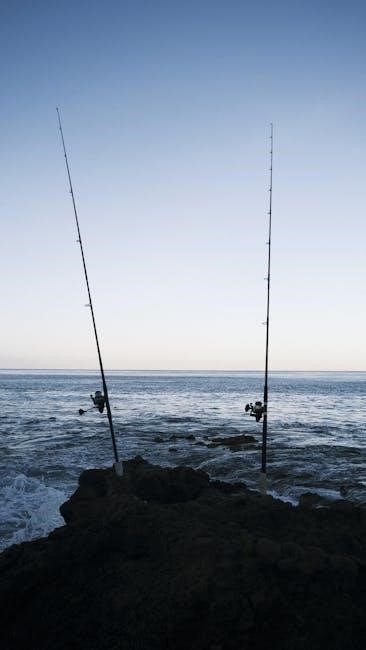
Popular Saltwater Fishing Techniques
Explore various methods like bottom fishing, trolling, casting, and fly fishing. Each technique targets specific species and water conditions, ensuring versatile and effective saltwater fishing experiences worldwide.
4.1. Bottom Fishing
Bottom fishing involves casting bait or lures near the seafloor to target species like grouper, snapper, and halibut. This method requires precise depth control and patience, often yielding substantial catches in both shallow and deep waters, making it a favorite among saltwater anglers worldwide for its reliability and exciting results year-round.
4.2. Trolling
Trolling involves casting lines or lures while moving the boat at a controlled speed, mimicking baitfish movement. This technique effectively targets pelagic species like tuna, marlin, and mahi-mahi. It’s highly versatile, working well in open oceans, reefs, and coastal areas, making it a popular method for catching large saltwater fish.
4.3. Casting and Retrieving
Casting and retrieving is a dynamic saltwater fishing technique. It involves accurately casting lures or baits and retrieving them with specific movements to mimic prey. This method excels for species like trout, redfish, and striped bass, requiring precise timing and varied retrieval speeds for optimal success.
4.4. Fly Fishing
Fly fishing is a precision technique ideal for saltwater fishing, targeting species like tarpon, bonefish, and permit. It involves casting lightweight or weighted flies to mimic baitfish or crustaceans. Patience and skill are key, as it demands accurate presentations and gentle retrieves to attract wary fish in clear waters.
Safety Precautions
Ensure safety with emergency kits, life jackets, and weather awareness. Always check forecasts, carry a first-aid kit, and inform someone of your fishing plans and expected return time.
5.1. Emergency Kits
Always carry a well-stocked emergency kit with first aid supplies, flares, a flashlight, multi-tool, and communication devices. Include water, non-perishable snacks, and a portable charger for extended trips. A whistle and reflective gear can signal for help if needed. Stay prepared for unexpected situations while fishing.
5.2. Life Jackets
A properly fitting Coast Guard-approved life jacket is essential for saltwater fishing. Choose between inflatable or foam types, ensuring it suits your weight and activity. Always wear it, especially in rough seas or bad weather. Regularly inspect for damage and ensure accessibility for all on board.
5.3. Weather Awareness
Always monitor marine forecasts and weather conditions before and during your trip. Understand tide cycles, wind patterns, and storm warnings; Be prepared for sudden changes, as weather can impact fishing success and safety. Stay informed using reliable apps or radios to ensure a safe and enjoyable experience on the water.
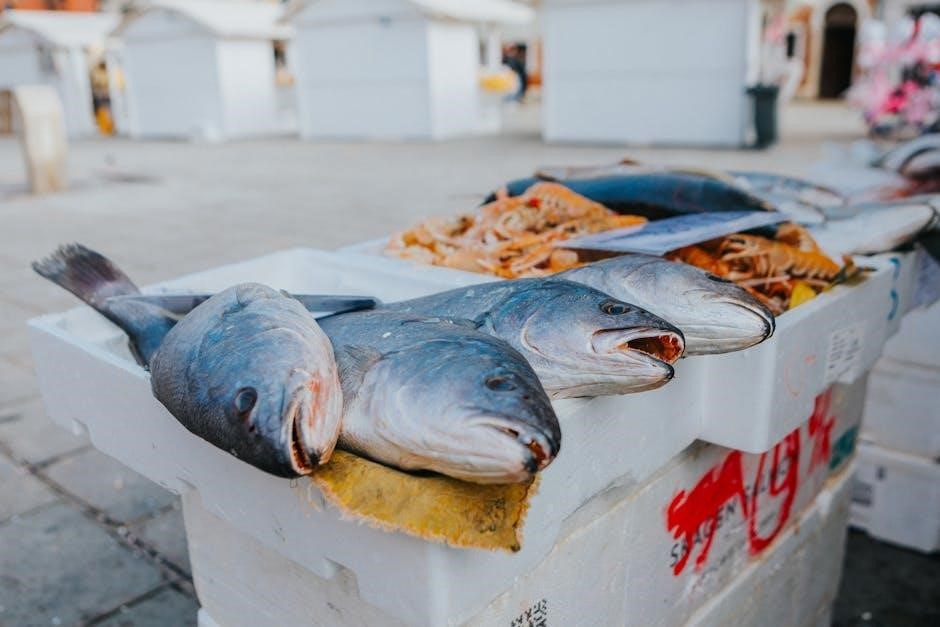
Fishing Regulations and Licenses
Obtain a valid fishing license to ensure compliance with local regulations. Adhere to catch limits, size restrictions, and gear rules to promote sustainable fishing practices and conserve marine populations.
6.1. Obtaining a Fishing License
To obtain a fishing license, visit your local fisheries department website or office. Provide required documents like ID and residency proof. Licenses vary by state and duration, ensuring compliance with regional regulations. This step is crucial for legal and sustainable saltwater fishing practices anywhere.
6.2. Catch Limits and Size Restrictions
Catch limits and size restrictions vary by species and location to ensure sustainability. Check local regulations for daily bag limits and minimum size requirements. These rules help conserve fish populations and maintain healthy marine ecosystems for future generations.
6.3. Gear Restrictions
Gear restrictions regulate the types of equipment used to protect marine life and habitats. Net sizes, hook types, and trap usage may be limited. These rules aim to minimize bycatch and preserve ecosystems, ensuring sustainable fishing practices and conservation of marine biodiversity.
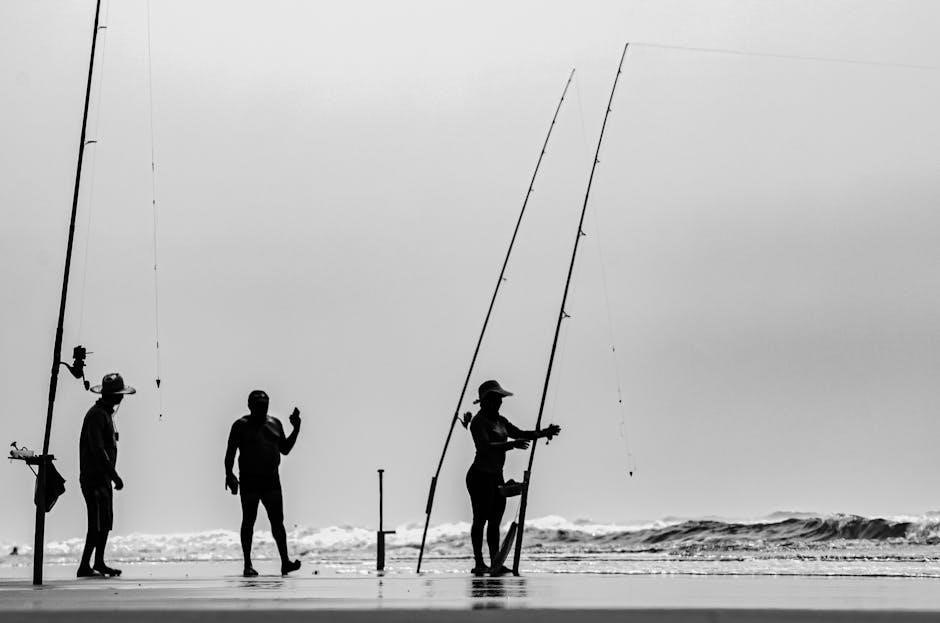
Choosing the Right Bait and Lures
Choosing the right bait and lures is crucial for successful saltwater fishing. Natural baits like live fish or squid and artificial lures such as spoons or plastic jigs attract specific species, ensuring effective results.
7.1. Natural Baits
Natural baits are highly effective in saltwater fishing, offering authentic appeal to marine species. Common choices include live or frozen baitfish, squid, shrimp, and crabs. These baits mimic natural prey, increasing the likelihood of attracting target fish like grouper, snapper, and larger predators effectively.
7.2. Artificial Lures
Artificial lures are versatile and popular for saltwater fishing, crafted from materials like metal, plastic, or feathers. Designed to mimic baitfish, crustaceans, or other prey, they come in various sizes and colors. Effective for casting, trolling, or jigging, lures are durable and often outlast natural baits, making them a practical choice.
7.3. How to Choose the Right Bait
Selecting the right bait involves matching it to your target species, water conditions, and time of day. Live bait like shrimp or mullet excels for bottom feeders, while lures mimic prey for predators. Always observe local prey activity to ensure your bait blends naturally with the environment for optimal results.
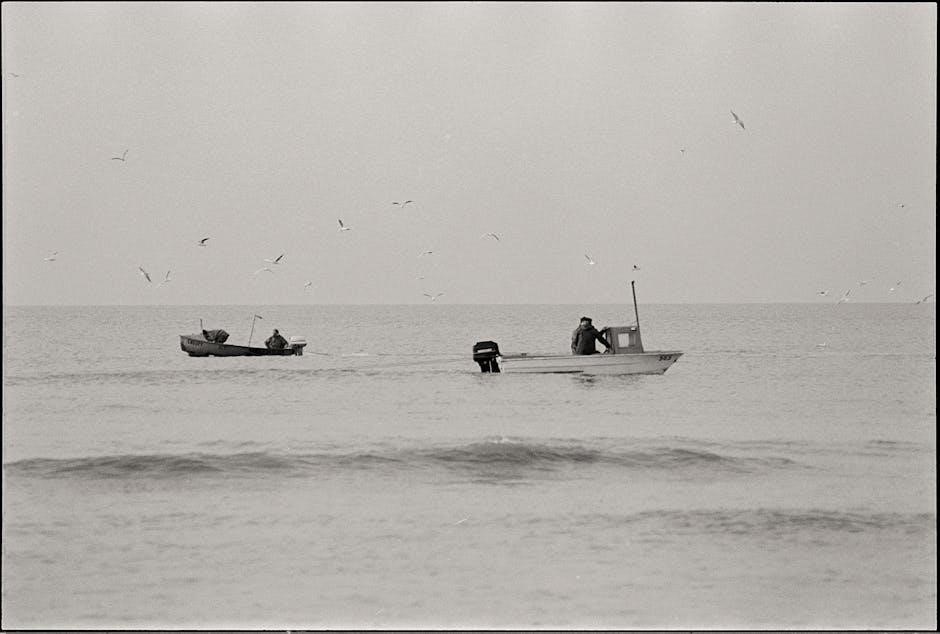
Boats and Equipment Maintenance
Regular maintenance ensures your boat and gear perform optimally. Inspect engines, clean equipment, and store properly to extend longevity and guarantee reliable performance during fishing trips.
8.1. Selecting the Right Boat
Selecting the right boat for saltwater fishing is crucial. Consider size, type, and features based on your fishing style and location. Flats boats are ideal for shallow waters, while offshore boats suit deep-sea adventures. Ensure durability and maneuverability for a successful fishing experience.
8.2. Regular Maintenance
Regular maintenance is vital for saltwater fishing boats. Check engines, propellers, and hulls for damage. Clean the hull to prevent marine growth and lubricate moving parts. Ensure electronics and safety gear are functioning properly to guarantee reliability and safety during your fishing trips.
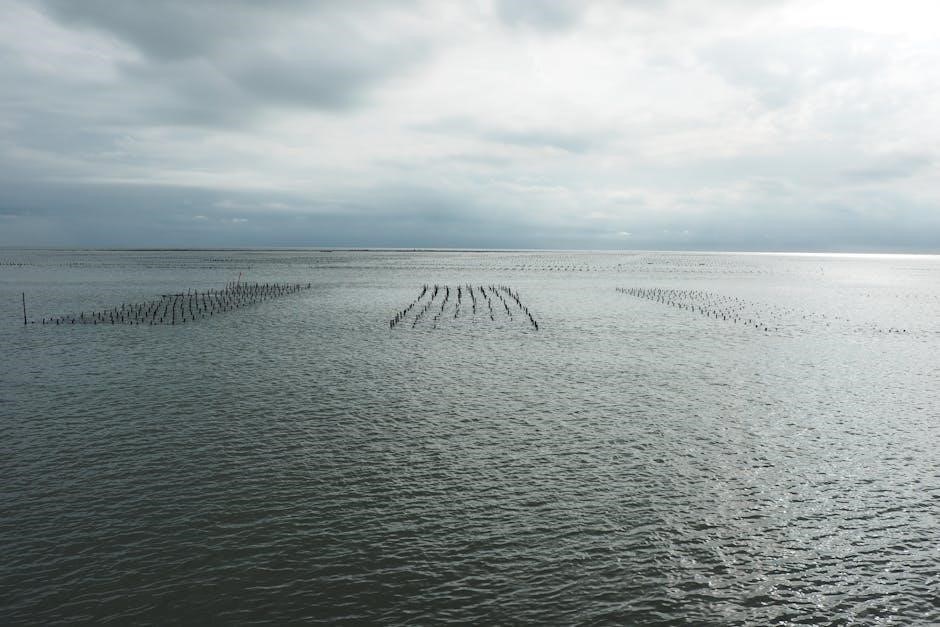
Tips for Beginner Saltwater Anglers
Beginners should start in calm waters like piers or beaches. Fish during early mornings or late afternoons for better catches. Patience and persistence are key.
9.1. Starting Spots
Beginners should start at piers, beaches, or shallow bays with calm waters. Look for structures like jetties or mangroves, as they attract fish. Focus on areas with bait activity or bird movements for better chances of catching fish. Simple gear and local advice can enhance your early fishing experiences.
9.2. Best Times to Fish
Fishing is most productive during dawn and dusk when fish are active. Tide changes, especially high tide, often trigger feeding. Stable weather conditions enhance fish activity. Plan trips during peak seasons for specific species and use tide charts to optimize your fishing schedule for better results.
9.3. Patience and Persistence
Patience and persistence are key to successful saltwater fishing, especially for beginners. Fish behavior can be unpredictable, so staying calm and composed is crucial. Even experienced anglers face challenges, but persistence often leads to rewarding catches. Keep waiting, adapting, and trying—effort always pays off in this exciting sport.
Conservation and Sustainability
Emphasize sustainable fishing practices to protect marine ecosystems. Implementing catch-and-release methods and respecting local regulations ensure the preservation of fish populations and their environments for future generations.
10.1. Catch and Release Practices
Catch-and-release fishing helps conserve fish populations by minimizing mortality. Handling fish gently, using barbless hooks, and releasing them quickly ensures their survival. This practice supports sustainable fishing and maintains healthy marine ecosystems for future anglers and biodiversity alike.
10.2. Protecting Marine Habitats
Preserving marine habitats is crucial for maintaining fish populations and biodiversity. Avoiding destructive gear, not littering, and respecting protected areas are key. Healthy habitats ensure sustainable fishing and support marine life, benefiting both the environment and anglers for generations to come.
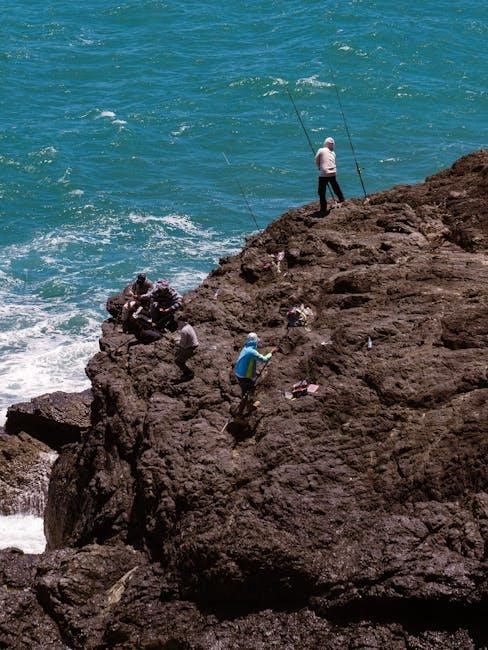
Planning Your Fishing Trip
Plan meticulously by choosing optimal locations, timing your trip around tides and weather, obtaining necessary permits, and packing essential gear and supplies for a successful adventure.
11.1. Choosing the Right Time
Timing is crucial for a successful trip. Research tidal patterns, weather forecasts, and fish behavior to determine optimal fishing hours. Consider peak fishing seasons and spawning periods for target species. Early mornings and late afternoons often yield the best results. Always check local fishing reports and moon phases for added insight.
11.2. Obtaining Permits
Ensure compliance with local regulations by obtaining the necessary saltwater fishing permits. Check state-specific requirements, as permits may vary. Apply online or in-person at local fisheries offices. Carry your permit while fishing to avoid penalties. Make sure it covers the type of fishing and gear you plan to use.
11.3. Packing Essentials
Pack essential gear like rods, reels, lines, hooks, bait, and lures. Include weather-appropriate clothing, sunscreen, and a first aid kit. Bring a cooler for catches and stay hydrated. Don’t forget snacks, a map, and emergency supplies like a flashlight and multitool for a safe, enjoyable trip.
Reading the Water and Identifying Fish Activity
Identify fish activity by observing bird movements, bait fish schools, and underwater structures. Look for ripples, color changes, and bubbles to locate active feeding zones effectively.
12.1. Looking for Bait Fish
Bait fish often gather in schools near the surface, creating visible ripples or disturbances. Use polarized sunglasses to spot their movements and identify larger fish feeding nearby. Their presence attracts predators, making them key indicators for successful saltwater fishing spots and strategies to target game fish effectively.
12.2. Identifying Underwater Structures
Underwater structures like reefs, rocks, and sunken ships attract fish by providing hiding spots and ambush points. Use side-scan sonar or depth sounders to locate these areas. Structures create habitats for bait fish, making them hotspots for larger predators and improving your chances of a successful catch.
12.3. Observing Bird Activity
Birds like seagulls and pelicans often indicate fish activity. Look for diving or hovering birds, as they reveal bait fish schools beneath the surface. Follow bird movements to locate feeding areas, increasing your chances of targeting predatory species effectively while fishing.